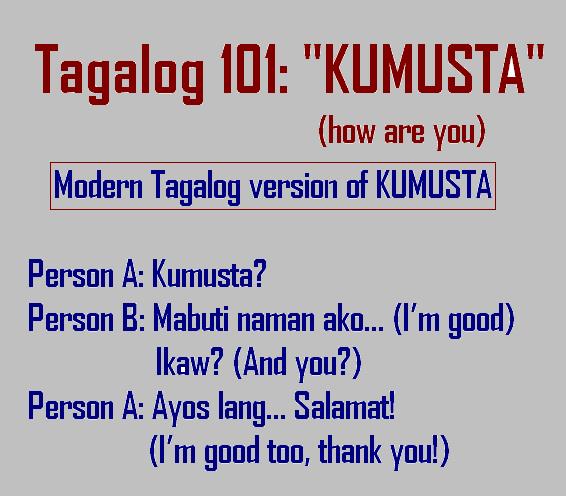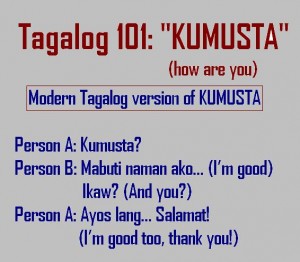Tagalog 101: KUMUSTA

We Filipinos are fond of having a conversation with almost everyone we meet. We love exchanging “HIs and HELLOs…” and expect us to always be there to keep you company if you need someone to talk to. The warm exchange of HOW ARE YOUs means a lot for us. Even if the conversation ends just right there, it makes our day a little lighter.
——————————————————————————
(press the play button to listen)
Here’s little background of the Filipino language based on the Wikipedia (http://en.wikipedia.org/wiki/Languages_of_the_Philippines)
Spanish was the national and official language of the country for more than three centuries under Spanish colonial rule… It was established that Spanish was spoken by a total of 60% of the population in the early 20th century as a first, second or third language. Following the American occupation of the Philippines and the imposition of English, the use of Spanish declined gradually, especially after the 1940s.
So let’s move forward. Now that we’re in the 21st century, do we still speak Spanish? Not anymore, but I have observed that there some words similar to Spanish like how you say “HOW ARE YOU”
In Spanish: ¿cómo está senor
In Tagalog: Kumusta ginoo?
In English: How are you, sir?
Notice that como esta and kumusta, almost sounded the same?
You can add the word “KA” pertaining to the person you are talking to.
Person A: Kumusta KA?
Person B: Mabuti naman ako… (I’m good) At Ikaw? (And you?)
Person A: Mabuti naman… Salamat (I’m good too, thank you!)
Most of the time, we drop the words “KA” and “AT”
Here’s the formal “How are you” in tagalog (with KA and AT)
Person A: Kumusta KA?
Person B: Mabuti naman ako… (I’m good) At Ikaw? (And you?)
Person A: Mabuti naman… Salamat (I’m good too, thank you!)
Here’s the short and modern way of saying it
Person A: Kumusta?
Person B: Mabuti naman ako… (I’m good) Ikaw? (And you?)
Person A: Ayos lang… Salamat! (I’m good too, thank you!)
Soon, we will learn how to use “po at opo.” (we use these words to show respect to the person we are speaking with)
We will teach you the basic Tagalog first to avoid confusion.
Watch out for our next module, How to say thank you and goodbye in Tagalog. Until next time, Mabuhay!
